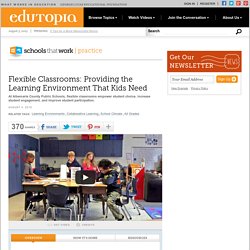

Rebooting Industrial Era Seating. While driving the back roads of Pennsylvania one summer, I (Tom) came across a carefully laid-out cemetery.

It grabbed my attention, so I pulled over for a closer look. As I perused the scenery, I noticed that all of the tombstones were equidistant from one another. The rows were impeccably aligned; each faced the same direction. Outlined by a stone wall, the plot of land was a perfect rectangle. With the exception of some updated landscaping, the space had remained seemingly untouched for a number of decades. Edutopia. I remember exactly where I was when I had a watershed moment that changed me as a teacher forever.

In fact, it inspired my EdSurge column, Why the 21st-Century Classroom May Remind You of Starbucks. Edutopia. Most educators have little choice about the (usually) over-crowded, (often) unappealing rooms they teach in -- but they intuitively know that the spaces children spend their time in can have an effect on how they learn.

I've gathered a collection of videos to explore the questions: How important is environment to learning? And what small changes can you make in seating, organization, lighting, and decor to build your own space into a better place to teach and learn? Video Playlist: Innovative Learning Spaces Watch the player below to see the whole playlist, or view it on YouTube. Flexible Learning Environments (04:02) Students and teachers at Eanes Independent School District in Austin, Texas, talk about the district's experiment with creating classrooms of the future to foster 21st-century skills at all grade levels.
More Resources on Learning Spaces. 20 Classroom Setups That Promote Thinking. 20 Classroom Setups That Promote Thinking by TeachThought Staff This is part 1 in our #iteachthought campaign.

Edutopia. Global Education Episode 5: Designing a school that reflects local culture. You're listening to the Global Education podcast series from Teacher magazine.

Hello, I'm Jo Earp. Throughout November we're exploring the theme of learning spaces. Earlier this month we brought you news of the World Architecture Festival awards. Learning spaces: The shifting lens. In 2003, I interviewed Herman Hertzberger, an architect from the Netherlands, for an article I was writing.

I was very much interested in his perspective on school design; for he understood that classrooms should offer a variety of activity settings to support the diverse ways that people learn. More importantly, he understood that learning should not be confined to the classroom, but rather must extend beyond the classroom, into corridor spaces (Lippman, 2013). Crafting collaborative places. School designs from around the globe. Throughout November, Teacher is exploring the theme of learning spaces.

To kick things off, we take a look at the latest developments in school design, showcased this week at the World Architecture Festival in Singapore. The Ballet School in St Petersburg, Russia, has just been named the winner of the School Buildings category at this year's World Architecture Festival. School design teams around the world face different challenges - from providing basic sanitation facilities and cool spaces in warm climates, to energy-efficient elements. The shortlisted projects were: The Ballet School, St Petersburg, Russia Lead Architect: Studio 44 Architects The Ballet School includes two new buildings – teaching and dormitory blocks.
The walls of the recreation spaces and ballet classes are realised in semitransparent glass, which serves to provide more natural light into the building. Baldivis Secondary College, Perth, Australia Lead Architect: JCY Architects & Urban Designers. Redesigning My Classroom Environment. I moved my classroom at the end of the school year.

I moved my posters, my bookshelves, and my computer cart. What I didn't move, however, were my traditional tables and chairs. I get to design a different kind of space next year, one that encourages different learners to work both independently and collaboratively. Edutopia. I decided to focus on learning spaces this year in the classroom and around my school.

It led me to create a makerspace in my school's library, but it also led me to take a hard look at the classroom. Last summer, I visited my classroom and decided to change it around. The entire process started with one simple question: "Is this room designed for me or for my students? " It was on this question that I based every decision I made when it came to designing the room. The Benefits of Desk-Free Teaching. Flexible Classrooms: Providing the Learning Environment That Kids Need. How it's done: Giving Students a Choice in How They Learn "From day one, I've said, 'You may sit anywhere you like as long as you're safe in our classroom,'" says Katie Collins, a Woodbrook Elementary School second grade teacher.

Becky Fisher, the director of educational technology at Albemarle County Public Schools, is interested in learning about the thinking that drives student choice. "What we're really striving for are those choices that have a lot of thought behind them. We want kids to really be strategic about where they go," Fisher says. She painted the picture of walking into a classroom and seeing kids: Lying on the floor Sitting at low tables on their knees Standing up. 20 Classroom Setups That Promote Thinking. 20 Classroom Setups That Promote Thinking by TeachThought Staff This is part 1 in our #iteachthought campaign. This is our equivalent to “back to school,” and is intended to help you focus in the 2015-2016 school year on taking a thoughtful approach to your craft as a teacher.
Among these shifts we’ll talk about is turning our focus from content and teaching to thinkers and thinking. This is a student-centered approach to pedagogy (and heautagogy), and will consist of three parts: